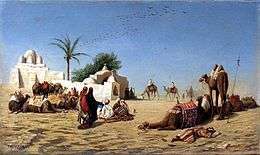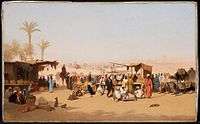Théodore Frère

Charles-Théodore Frère (21 June 1814, Paris – 24 March 1888) was a French Orientalist painter.
Biography
The son of a Paris music publisher, Frère studied at the École des Beaux-Arts under Jules Coignet and Camille Roqueplan. On completing his studies, he travelled throughout France visiting Alsace, Auvergne and Normandy. On returning to Paris, he exhibited Vue des Environs de Strasbourg at the 1834 Paris Salon. His exhibits at the Salon in subsequent years were nearly all Orientalist paintings as a result of several journeys to Africa and the Near East.[1]
After a stay in Algiers in 1836, he left with the army for Constantine which was taken on 13 October 1837, returning to Paris in 1839. Like his younger brother Pierre-Édouard, he was a prolific painter. During his first trip to Algeria, he completed works for the King of Württemberg. Around 1851, he undertook a further journey to the Near East, visiting Malta, Greece, Egypt and Turkey becoming one of the few artists to paint Beirut, Damascus and Palmyra. In 1853, he established a studio in Cairo, becoming the court painter there. The viceroy of Egypt elevated him to the rank of bey.[1]
In 1869, he once again travelled to the Egypt, now as a member of Empress Eugénie's party, for the opening of the Suez Canal. She commissioned a series of watercolours which could not be delivered to her owing to the 1870 Franco-Prussian War. Instead they were given to her friend and pupil, the Marquis of Puisaye.
Selected works
- Vue de la Ville de Constantine (1841)
- La Prise de Constantine (1843)
- Vue de la Mosquée Sidi Abd-Er-Raham
- Scène de marché au Caire (1864)
- Le café Jalata à Contantinople (1865)
- l’Ile de Philae (1865)
- Scène de rue au Caire (1869)
- Jérusalem vue de la vallée de Jéhosafat (c. 1881)
 Scène de marché au Caire (1864)
Scène de marché au Caire (1864) Vue de la Ville de Constantine (1841)
Vue de la Ville de Constantine (1841) Jérusalem vue de la vallée de Jéhosafat (c. 1881)
Jérusalem vue de la vallée de Jéhosafat (c. 1881)
References
- 1 2 "Charles Theodore Frere", Rehs Galleries. Retrieved 3 May 2012.
Sources and bibliography
- Clarence Cook, Art et Artistes de notre temps, 1888.
- Charles Stranahan, Histoire de la peinture française, New York, Charles Scriner, 1888, p. 228.
- Lorinda Munson Bryant, Images et peintres français, London, T Fischer Unwin., 1923, p. 111.
- J. R. Soubiran, Le Paysage Provençal et l’École de Marseille avant les Impressionnistes, 1845-1874, Musée de Toulon, 1992, pp. 94–95.
- Dictionnaire Bénézit, Gründ, Paris, 1999.
- Marion Vidal-Bué, L’Algérie des peintres, Éditions Paris-Méditerranée, 2002, pp. 144–7.
- Elisabeth Cazenave, L’Afrique du Nord révélée par les Musées de Province, Edt, Bernard Giovangeli Association Abd el Tif, 2004, p. 49 and p. 483.
- Catherine Granger, L’Empereur et les arts, la liste civile de Napoléon III, Edt de l’École des Chartes, 2005, p. 866.
| Wikimedia Commons has media related to Charles Théodore Frère. |